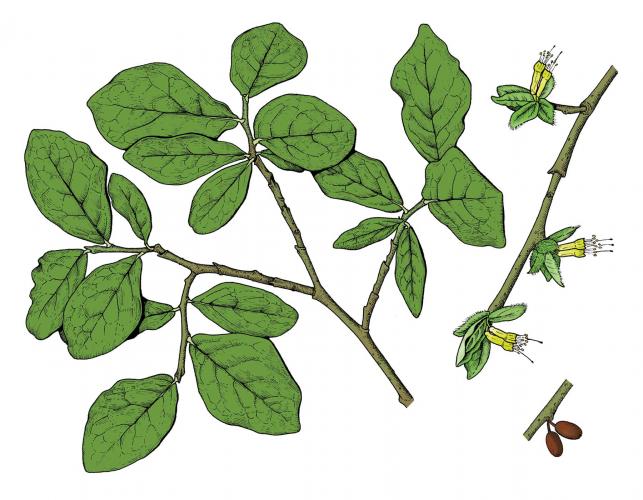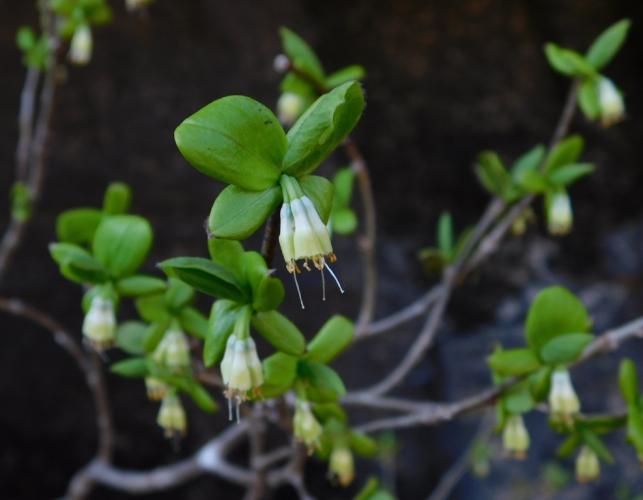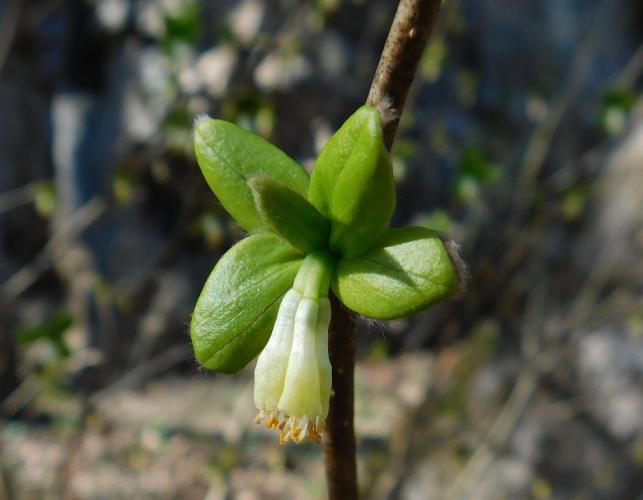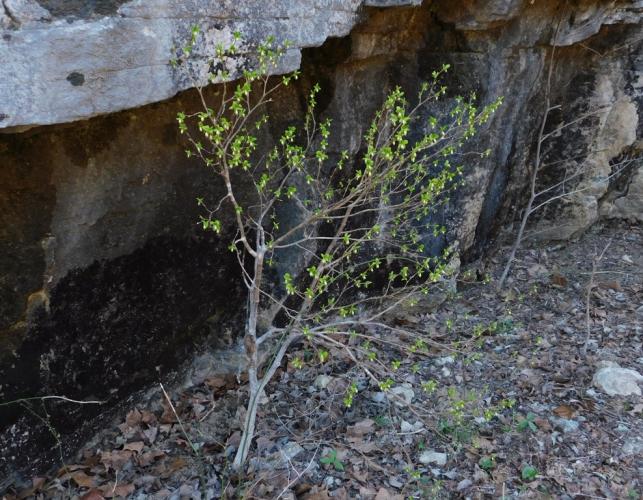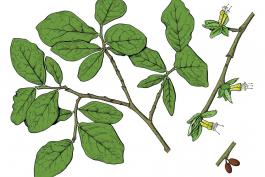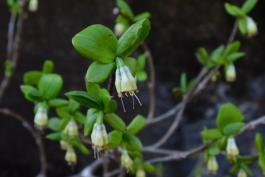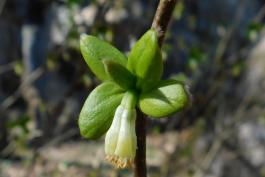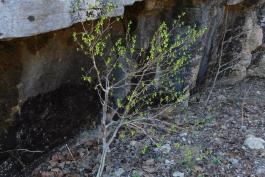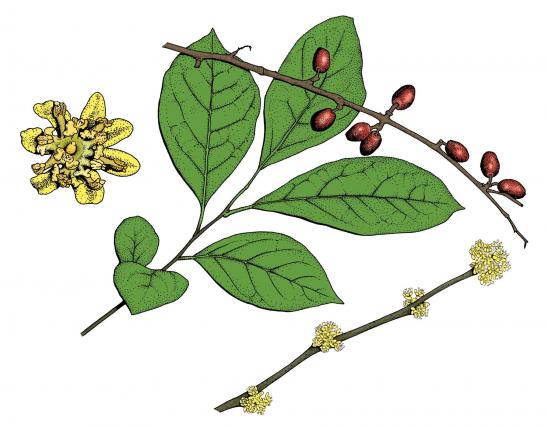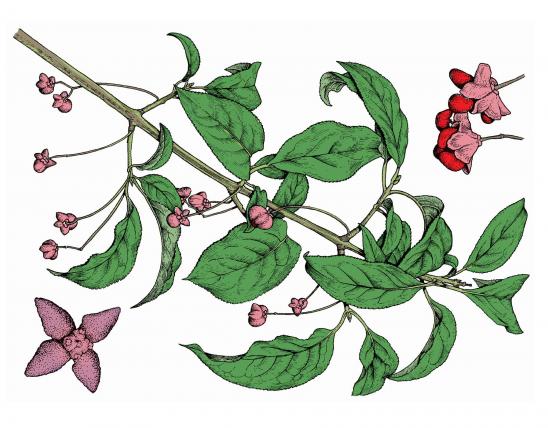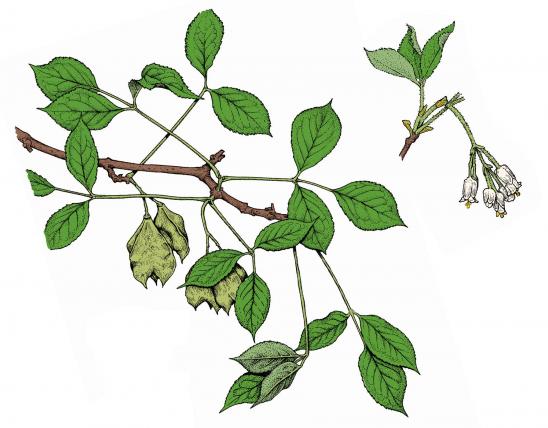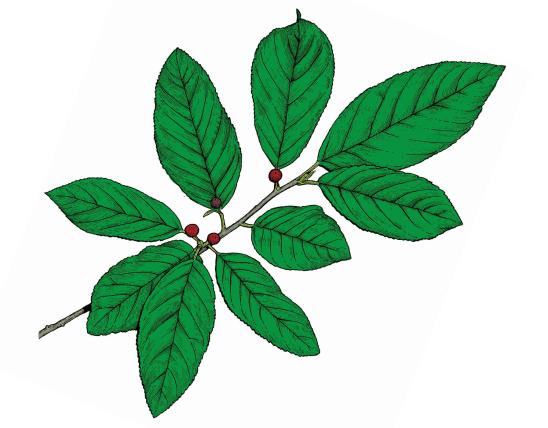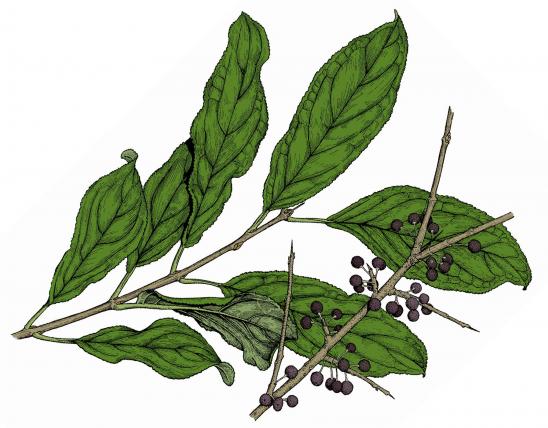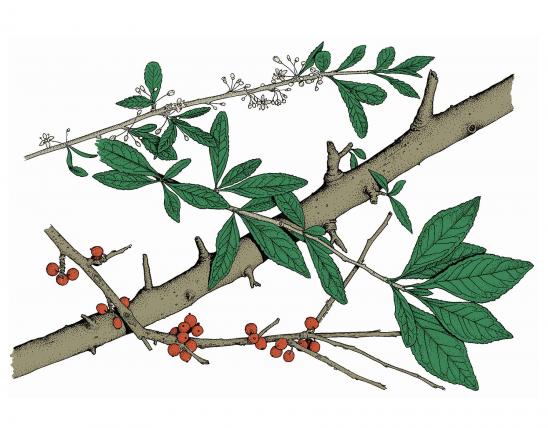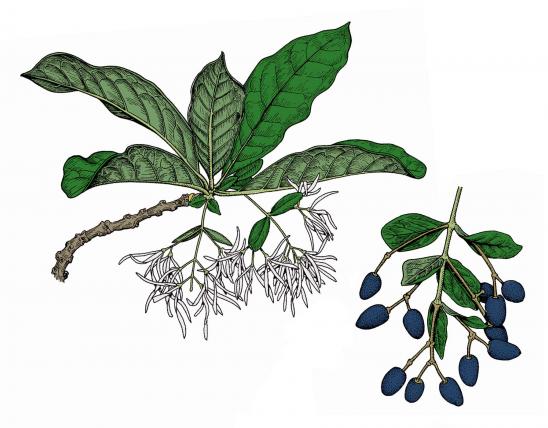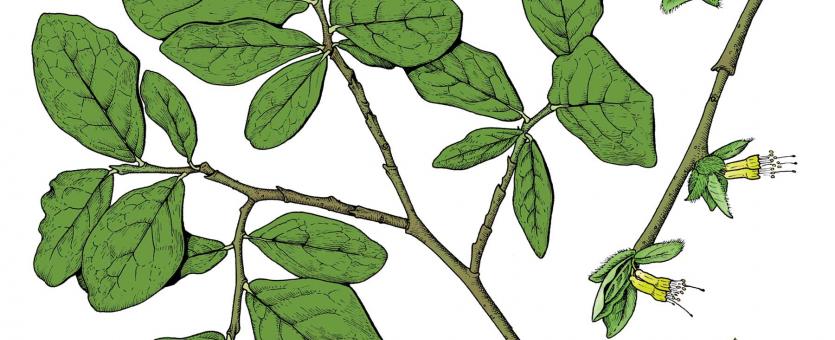
Eastern leatherwood is a widely branching, usually several-stemmed shrub to 7 feet tall; if single-stemmed, the trunk can be 4 inches in diameter. It sometimes looks like a miniature tree.
Leaves are numerous, simple, alternate, oval to broadest above the middle, the tip blunt to somewhat pointed, the base narrowed or rounded, the margin entire, the blade 2–4 inches long, 2¾ inches wide; the surface hairy when immature, light green and smooth later, the lower surface with a whitish coat and somewhat hairy; the leaf stalk short, to ⅛ inch long, hairy, and hollow. The next year’s leaf buds are hidden and covered by the base of the leaf stalk.
Bark is mostly smooth and gray on old stems and roughened at the base of old trunks; very tough. Wood is soft, white, and brittle when dried.
Twigs are yellowish brown or reddish brown and smooth, stems ringed by circular scars at the beginning of the new growth. The twigs are very flexible and are capable of being bent or even tied into knots without breaking. They are enlarged at the joints.
Flowers late March–April, flowering before the leaves, the flowers falling off when the leaves expand. Flowers fairly abundant, occurring at the leaf axils, in clusters of 2–4 flowers. The flower tube is the calyx (joined sepals; petals are absent) and is about ¼ inch long, yellow, and unlobed, the margin merely irregular and/or with tiny scallops. Stamens 8. The stalks of the flower clusters are about ⅛–⅜ inch (2–7 mm) long at flowering, elongating to about ¼–½ inch (5–13 mm) at fruiting time. The stalks of individual flowers are smooth and up to about ⅜ inch (1–10 mm) long; sometimes 2 or more of these stalks are fused nearly to the tips. The persistent bracts at the base of the flower clusters are woolly-hairy on the undersurface with dense, dark brown (sometimes light or grayish brown) hairs.
Fruits May–June, sometimes hidden by the dense foliage, dropping early. The stalks are ⅛–⅜ inch long. Fruit usually pale green or yellowish, sometimes strongly tinged with red or purple, often turning darker and redder with age; oval to egg-shaped; ¼–⅜ inch long; smooth at the tip. Each fruit bears a single, dark brown seed.
Similar species: Leatherwood is a rather unusual, knobby-jointed shrub. Once you get to know it and have bent the twigs back a few times, you tend to remember it. Here are two relatives you may encounter in Missouri:
Ozark leatherwood (D. decipiens) is a recently described close relative of eastern leatherwood. It is uncommon in the southern half of the state, on bases and ledges of dolomite bluffs and steep slopes in moist upland forests. Because of its rarity and restriction to a fairly small region, it is ranked globally as imperiled. In Missouri it has been officially recorded from Gasconade and Oregon counties. Its Missouri distribution and abundance are still not well understood, so it may be more common in our state than initial reports indicate. Here are some of the ways to distinguish it from eastern leatherwood:
- Its twigs are hairy (not glabrous); the flower clusters are stalkless, or develop a stalk only to 1 mm long at flowering; this stalk does not elongate noticeably as the fruits mature.
- The individual flowers have hairy stalks to only about 2 mm long, even at fruiting time.
- The persistent bracts that subtend the flower/fruit clusters are hairy on the undersurface with white, gray, or light brown (not dark brown) hairs.
- The funnel-shaped or tubular calyx (joined sepals) has 4 irregular lobes 1–3 mm long, with the margins also irregular or minutely scalloped (not unlobed but merely irregular or minutely scalloped).
- Finally, the ovaries and fruits have an inconspicuous tuft of short hairs at the tip (not glabrous).
A native of Europe, spurge flax, or sparrow-wort (Thymelaea passerina), is in the same family. It has not been discovered in Missouri, but it has become established in several states, including Illinois, Wisconsin, Iowa, South Dakota, Nebraska, Kansas, Texas, Mississippi, Alabama, and Ohio. It is not likely to be confused with leatherwood. It is a nondescript, weedy species that is considered invasive in many states.
- It is not a shrub but is a tap-rooted, nonwoody annual. It has slender, upright, wiry stems that branch toward the top.
- Its leaves are alternate, narrow, and pointy-tipped.
- It spreads aggressively, and like other members of the family, it has bitter, toxic compounds that make it unpalatable to livestock, so it tends to increase in pastures and in disturbed soils.
Height: usually 2–6 feet; sometimes to nearly 11 feet.
Scattered in the Ozarks and Ozark border, and north locally to Audrain County.
Habitat and Conservation
Occurs in bottomland forests, moist upland forests (usually along north- and east-facing slopes of valleys), terraces above streams and rivers, and bases and ledges of bluffs.
Leatherwood is a slow-growing shrub. A specimen with a trunk only 2 inches in diameter may be more than a century in age.
Eastern leatherwood is one of the earliest-flowering shrubs in Missouri. It apparently begins to flower about a week earlier than the similar-looking Ozark leatherwood. The fruits also mature quickly (often by the end of April).
Status
Native lowland shrub with interesting flowers, leaves, and twigs. It blooms early and makes a good ornamental plant.
Human Connections
Leatherwood is a good ornamental plant. It grows slowly and is adjustable to many soil types. It is relatively free from insects and diseases, and when grown in the open it develops a well-rounded crown. The leaves turn yellow or greenish yellow in the fall.
The stems of leatherwood have relatively little lignin and very light wood, so they are surprisingly flexible and have been used in cordage (rope-making) and basketry, notably by Native Americans, who also used it for sandals and to sew up bark canoes. American settlers used it as a withe — a strong, flexible twig used as a band to bind things together.
Some people are sensitive to the bark, with their skin becoming irritated or blistered after contact. Leatherwood bark has in the past been used as an emetic and purgative (to produce vomiting or bowel movements). The fruits can cause a strong allergic reaction in the mouth and throat. The various tissues of leatherwood have a bitter flavor, so few people or animals would dream of consuming very much of this plant and its toxic compounds.
Most plants in the mezereum family produce a variety of potentially toxic compounds and are variously considered mildly to strongly poisonous. The family has limited economic importance, including some trees used in the tropics for timber, and some incense plants. In various parts of the world, the bark of several species has been used to make paper and cordage.
Eurasian relatives of leatherwood in the genus Daphne are cultivated as ornamental shrubs, and some are used for a variety of medicinal purposes.
The genus name, Dirca, is from Dirce, the name of a character in Greek mythology. The wife of Lycus, the ruler of Thebes, her name means “double” or “cleft.” She was a devotee of the god Dionysus, and he caused a spring or a well to appear at the place she was murdered. A stream near Thebes was named after her, and her name is forever associated with flowing water. Eastern leatherwood is likewise associated with streams.
The species name, palustris, means “growing in the marsh” and refers to the plant’s habitat in low, wet soil.
The name leatherwood is for the tough, bendable stems. This plant was named at a time when leather was commonly used for binding and tying things up. Today, we might have named it “zip-tie wood.”
Henry David Thoreau saw leatherwood for the first time on September 7, 1853, and wrote about it in his journal: “I was much interested in this shrub, since it was the Indian’s rope. Frost said that the farmers of Vermont used it to tie up their fences. . . . I should think it would be worth the while for the farmers to cultivate [leatherwood] for this purpose. How often in the woods and fields we want a string or rope and cannot find one. This is the plant which Nature has made for this purpose. . . . I feel as if I had discovered a more indigenous plant than usual, it was so peculiarly useful to the aborigines.”
Ecosystem Connections
Shrubs that bloom in early spring offer nectar and pollen at an important time for many insects. A variety of native bees visit the flowers. Many queen bees, newly emerged from overwintering, use it as an energy source. Mourning cloak butterflies, which overwinter as adults and therefore may start flying around on the first warm days of spring, also take nectar from leatherwood blossoms.
Leaf miners, scales, and flea beetles may feed on the leaves. The caterpillars of the groovy-looking Harris’ three spot, a noctuid moth, may eat leatherwood leaves, though they are not limited to them.
Because all parts of leatherwood are toxic or at least bitter, few mammals eat this plant. Even birds that usually eat berries seem to avoid it.
The fruits of leatherwood are buoyant and can float downstream to take root away from the parent plant. Leatherwood’s placement in the landscape (along streamsides) and timing of the fruit’s maturity (late spring, when rain showers and flash flooding are typical) optimize this dispersal-by-water strategy.
In addition to eastern leatherwood, which is relatively widespread in the eastern United States and Canada, the genus Dirca consists of only three additional species, which are uncommon and have limited distributions. These include Ozark leatherwood (described above under Similar Species), plus one that is limited to northern California (D. occidentalis, or western leatherwood), and one known only from a small area in northeastern Mexico (D. mexicana).
Leatherwood is in the Thymeleaceae, which is an oddball family for Missouri. Only two species of Dirca (leatherwoods) have been recorded in our state. People call it the “mezereum family” because some of species in genus Daphne are cultivated as ornamental shrubs — and one of these is D. mezereum, commonly called just “mezereum.” A native of Europe and western Asia, it bears pinkish-purple flowers, followed by bright red, toxic fruits, clustered along its branches.
The mezereum family is not large. Globally, there are only about 45 genera, with 850 species. They are most diverse in the Southern Hemisphere, especially in Africa and Australia.
